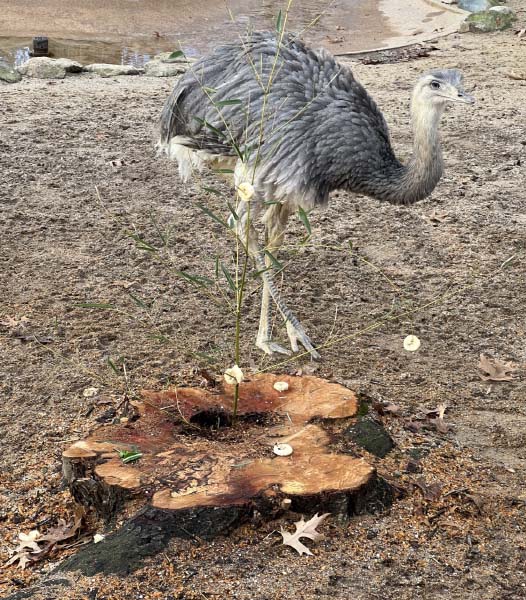Mya Williams ’25 Soars in Smithsonian Bird House Internship

It’s not every day that a student gets to work with some of the world’s biggest—and most dangerous—birds. But for Mya Williams, who recently earned her master’s degree in biology from American University, that was just part of the job.
As a zookeeper intern at the Smithsonian National Zoo, Mya spent her final semester in the newly renovated Bird House. She handled everything from feeding delicate shorebirds to prepping meals for powerful owls and kori bustards. Her day began with sorting insects—mealworms, waxworms, crickets, and superworms—all weighed and portioned for each bird’s diet. After sink-filling and dishwashing to meet strict hygiene standards, she moved on to aviary maintenance and morning feedings.
Mya worked hands-on with mockingbirds, parakeets, flamingos, and ratites, learning food placement, veterinary protocols, and species-specific cleaning tasks. She even fed small horseshoe crabs to mimic natural shorebird habitats. Afternoons were spent on exhibit upkeep, assisting with wing trims and antibiotics, and observing advanced procedures like beak and nail trims.
Every day ended with bird enrichment—a highlight of the job. “The ducks receive mealworms by diving for them in water, songbirds capture live crickets in their enclosures, and a flamingo runt might wander an office space to gain physical strength,” she says.
A Challenging Project
 For her formal internship project, Mya took on a challenge: training giant, flightless birds—cassowaries and greater rheas—to accept food, medication, and even medical treatments from their keepers.
For her formal internship project, Mya took on a challenge: training giant, flightless birds—cassowaries and greater rheas—to accept food, medication, and even medical treatments from their keepers.
“My project focused on proximity training,” Mya explains, “with the long-term goal of getting these birds comfortable enough to voluntarily receive things like x-rays or blood draws. Over time, we saw real progress. The birds became more eager to interact and showed fewer signs of stress.”
The Cassowary Brothers: Irwin and Marvin
Cassowaries—towering up to six feet tall and weighing as much as 160 pounds—are striking birds with bright blue heads, prehistoric features, and powerful legs capable of delivering lethal kicks. Widely regarded as the world’s most dangerous birds, they typically require heavy sedation during health checks to ensure everyone’s safety.
But at the National Zoo, zookeepers are working to reduce that risk by training cassowaries to tolerate basic exams without sedation.
That’s where Mya came in. Her job was to help two cassowary brothers, Irwin and Darwin, get comfortable with human interaction. Armed with a pan of food and a lot of patience, Mya began handfeeding the birds to build trust and reduce their stress. She also introduced the first steps of target training—teaching them to peck at a pole and respond to simple cues in exchange for treats.
She also observed their personalities. “Irwin was easier to hand-feed and even allowed a quick touch during training,” she says. “Darwin was more skittish and took longer. At first, he did a lot of circling and avoiding before deciding to take food from my hand.”
Before Darwin warmed up to her, Mya recalls, “he sat on the ground with his feet straight out—a very funny image to see from such a dangerous animal. During Irwin’s feedings, he’d be face-level at the door and loved to stick his head out and look around the shed.”
Greater Rheas: Gentle Giants
 Mya also worked with four greater rheas, a gentle, shy bird species, similar to ostriches and emus, with long necks and legs, soft gray or brown feathers, and big, expressive eyes.
Mya also worked with four greater rheas, a gentle, shy bird species, similar to ostriches and emus, with long necks and legs, soft gray or brown feathers, and big, expressive eyes.
Her job was to encourage the birds to approach platforms used during routine x-rays. She began by offering food to see if they’d come closer. Over weeks, the birds grew more comfortable, and she introduced the platform into their enclosure.
It was a success. “All four rheas interacted with the platform during feeding,” she says, “and generally didn’t mind it at all.”
Hands-On Work, Hands-On Learning
Mya worked three days a week, starting at 6:30 a.m., each day packed with hands-on experience. She learned to identify bird species and sex based on subtle traits, understand the rhythms of husbandry, and help capture and treat delicate birds. She studied animal behavior—especially territorial and breeding instincts—and saw how enrichment supports mental and physical health.
“It’s a very demanding and risky role that requires full attention. But the internship was incredibly beneficial for my long-term career goals and educational development,” Mya says. “I got to work with incredible animals, contribute to long-term care goals, and apply what I’ve learned in a real-world setting.”
Now, after earning her master’s degree in May, Mya continues volunteering at the Bird House while exploring several promising opportunities in environmental and wildlife work across the United States.